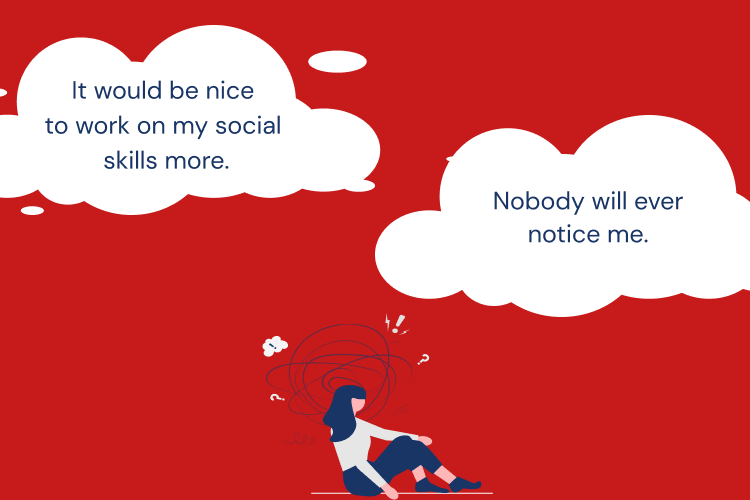7 Tips for Dealing With Negative Thoughts
Negative thoughts don’t necessarily mean apparent gloominess, depression, or torturing anxiety. Sometimes, it’s just a background thinking pattern that defines the way we react to what’s happening around us.
Anyway, the longer that thinking pattern persists, the worse its impact on our physical and mental state. Until apparent gloominess, depression, and torturing anxiety begin actually developing.
How do you Define a Negative Thought?
A negative thought is a dysfunctional thinking pattern, also called an “automatic thought.” It’s an involuntarily triggered cognitive response to a challenging situation, often generalizing and painting a pitch-black picture where there are multiple shades of grey.
An automatic negative thought is when you say to yourself, “I’m a total failure” instead of “I simply couldn’t cope with this task.”
It’s also when you say to yourself, “I will never trust people again” instead of “I was let down, and I’ve learned my lesson,” or “My life is ruined” instead of “I’m supposed to change my ways in order to move on.”
As you may already suggest, these thoughts tend to produce a direct impact on our lives – in matters of emotional resilience, life events, and even physical health.
How do Negative Thoughts Affect Your Well-Being?
Emotionally speaking, persistent negative thoughts can result in anything from a bad mood to anxiety, anger, self-esteem issues, and even depression.
Also, they can get very physical by manifesting our thinking as higher blood pressure, increased risk of developing heart disease, lower immune system, higher level of stress hormones, or insomnia.
Put shortly – bad thoughts can literally get you sick! So – what is there to do about them?
Everyday Strategies for Dealing with Negative Thoughts
Here is our little guide for dealing with negative thinking in your everyday life:
#1 Learn to Recognize Thought Distortions
According to Psychology Today, there are four kinds of thought distortions:
- Black and white thinking – classifying events as either satisfactory or disastrous, with nothing in-between.
- Personalizing – believing that anything that goes wrong is always your fault.
- Catastrophizing – expecting the worst outcome of any situation.
- Filter thinking – recognizing only the negative side of any situation.
Analyzing your thoughts and recognizing a dysfunctional thinking pattern you have is the first and most crucial step towards fixing it.
#2 Re-Evaluate Your Situation
Once you feel that automatic thought starting to creep in, try to distance yourself from it and change your perspective. For example, what would you say to someone else in your situation? What would it look like to you if you were not personally involved?
That’s right – negative thoughts almost always keep you from being realistic, and reality is probably way better than you perceive it subjectively.
#3 Feel it Before you Let it Go
Frantically running away from bad thoughts is never a good strategy, as a person’s emotional spectrum is not (and is not supposed to be) monochrome. Instead, spend your time with your frustration – sit back, feel it, live through it, and, finally, dominate it.
Feeling sad or angry is ok. It simply doesn’t mean you have always felt that way, or you’ll be feeling that way forever.
#4 Don’t Keep it All to Yourself
Sometimes, other people’s opinions and support can be of great help in overcoming negative thinking. As hard as it may be for you, try to share your concerns and emotions with another person – communicate it, talk it through, and make an effort to accept advice from the outside.
You can talk with a friend, a relative, a significant other, or a professional psychologist – it’s all fine when it makes you feel fine.
#5 Count Your Blessings
The good old balance scale strategy comes in handy when negative thinking makes you feel down. This approach is very simple – you are supposed to merely think about the good things you have in your life. The things you are grateful about and rarely appreciate on a daily basis.
Be it your family, your child, your pet, your talents, or your passions – make a little list of blessings and keep it present in your conscious thoughts every time you begin to slide off.
#6 Make a Lifestyle Change
Negative thinking is harder to win when you take better care of your general well-being. Where to begin?
- Eat better;
- Sleep more;
- Socialize more often;
- Spend more quality time with your loved ones;
- Do not systematically overwork yourself;
- Engage in more dynamic physical activities;
- Spend time in nature.
At the end of the day, you will be startled by the massive difference that little things can make.
#7 Practice Automatic Thoughts Recognition in RelaxifyApp
In our RelaxifyApp, we’ve designed a playful and engaging experience based on science that will help you reconsider your patterns of thinking.

By spending just a couple of minutes per day playing the Negative Thoughts mind game, you will become increasingly aware of dysfunctional thinking and learn to control it – for a better mood and a better life.
Because every positive change begins with the notion that something needs to change and the conscious effort to change it the healthy way!

